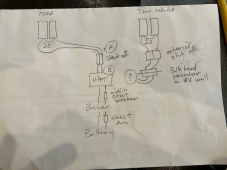jameshowison
New Member
- Joined
- Jul 30, 2021
- Messages
- 184
I'm considering adding panels on the roof of a camper shell on my tow vehicle for a travel trailer RV. The set of panels would be identical to the set on the roof of the RV. I would have a female connector on the truck. When the truck is added in (while driving, when truck is at camp) that would double the capacity, but VoC etc would always be the same.
Two questions:
I don't think these would need to be fused. The combined amps of the parallel array would be below the "Maximum Series Fuse Rating" (15 amps) as the Imp of each panel is below 6amps. Do I have that right?
How to bring these together? Currently the rooftop RV panels have a shutoff using a DC rated DIN rail mounted breaker. I think that breaker is rated for two conductors in its bottom terminals. Can I just run the second string in there? Or would you cut an MC4 parallel connector into the existing line before the shutoff?
One concern is that the energy from the RV panels would always be present on the disconnected RV male end of the connection to the truck (since the shut off is upstream from the branching point). That doesn't seem right. So that suggests that each parallel string should have its own shut off, closer to the panels than the branching point. Don't usually see that in diagrams, but then again panels aren't being added and removed often!
Two questions:
I don't think these would need to be fused. The combined amps of the parallel array would be below the "Maximum Series Fuse Rating" (15 amps) as the Imp of each panel is below 6amps. Do I have that right?
How to bring these together? Currently the rooftop RV panels have a shutoff using a DC rated DIN rail mounted breaker. I think that breaker is rated for two conductors in its bottom terminals. Can I just run the second string in there? Or would you cut an MC4 parallel connector into the existing line before the shutoff?
One concern is that the energy from the RV panels would always be present on the disconnected RV male end of the connection to the truck (since the shut off is upstream from the branching point). That doesn't seem right. So that suggests that each parallel string should have its own shut off, closer to the panels than the branching point. Don't usually see that in diagrams, but then again panels aren't being added and removed often!




